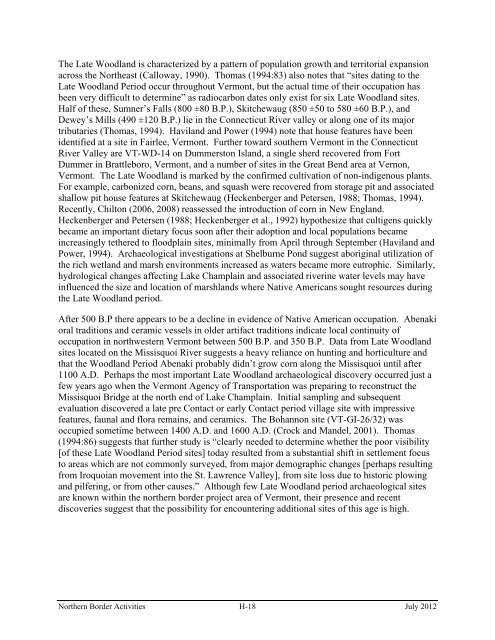Appendix H - Historical Archaeological and ... - CBP.gov
Appendix H - Historical Archaeological and ... - CBP.gov
Appendix H - Historical Archaeological and ... - CBP.gov
You also want an ePaper? Increase the reach of your titles
YUMPU automatically turns print PDFs into web optimized ePapers that Google loves.
The Late Woodl<strong>and</strong> is characterized by a pattern of population growth <strong>and</strong> territorial expansion<br />
across the Northeast (Calloway, 1990). Thomas (1994:83) also notes that “sites dating to the<br />
Late Woodl<strong>and</strong> Period occur throughout Vermont, but the actual time of their occupation has<br />
been very difficult to determine” as radiocarbon dates only exist for six Late Woodl<strong>and</strong> sites.<br />
Half of these, Sumner’s Falls (800 ±80 B.P.), Skitchewaug (850 ±50 to 580 ±60 B.P.), <strong>and</strong><br />
Dewey’s Mills (490 ±120 B.P.) lie in the Connecticut River valley or along one of its major<br />
tributaries (Thomas, 1994). Havil<strong>and</strong> <strong>and</strong> Power (1994) note that house features have been<br />
identified at a site in Fairlee, Vermont. Further toward southern Vermont in the Connecticut<br />
River Valley are VT-WD-14 on Dummerston Isl<strong>and</strong>, a single sherd recovered from Fort<br />
Dummer in Brattleboro, Vermont, <strong>and</strong> a number of sites in the Great Bend area at Vernon,<br />
Vermont. The Late Woodl<strong>and</strong> is marked by the confirmed cultivation of non-indigenous plants.<br />
For example, carbonized corn, beans, <strong>and</strong> squash were recovered from storage pit <strong>and</strong> associated<br />
shallow pit house features at Skitchewaug (Heckenberger <strong>and</strong> Petersen, 1988; Thomas, 1994).<br />
Recently, Chilton (2006, 2008) reassessed the introduction of corn in New Engl<strong>and</strong>.<br />
Heckenberger <strong>and</strong> Petersen (1988; Heckenberger et al., 1992) hypothesize that cultigens quickly<br />
became an important dietary focus soon after their adoption <strong>and</strong> local populations became<br />
increasingly tethered to floodplain sites, minimally from April through September (Havil<strong>and</strong> <strong>and</strong><br />
Power, 1994). <strong>Archaeological</strong> investigations at Shelburne Pond suggest aboriginal utilization of<br />
the rich wetl<strong>and</strong> <strong>and</strong> marsh environments increased as waters became more eutrophic. Similarly,<br />
hydrological changes affecting Lake Champlain <strong>and</strong> associated riverine water levels may have<br />
influenced the size <strong>and</strong> location of marshl<strong>and</strong>s where Native Americans sought resources during<br />
the Late Woodl<strong>and</strong> period.<br />
After 500 B.P there appears to be a decline in evidence of Native American occupation. Abenaki<br />
oral traditions <strong>and</strong> ceramic vessels in older artifact traditions indicate local continuity of<br />
occupation in northwestern Vermont between 500 B.P. <strong>and</strong> 350 B.P. Data from Late Woodl<strong>and</strong><br />
sites located on the Missisquoi River suggests a heavy reliance on hunting <strong>and</strong> horticulture <strong>and</strong><br />
that the Woodl<strong>and</strong> Period Abenaki probably didn’t grow corn along the Missisquoi until after<br />
1100 A.D. Perhaps the most important Late Woodl<strong>and</strong> archaeological discovery occurred just a<br />
few years ago when the Vermont Agency of Transportation was preparing to reconstruct the<br />
Missisquoi Bridge at the north end of Lake Champlain. Initial sampling <strong>and</strong> subsequent<br />
evaluation discovered a late pre Contact or early Contact period village site with impressive<br />
features, faunal <strong>and</strong> flora remains, <strong>and</strong> ceramics. The Bohannon site (VT-GI-26/32) was<br />
occupied sometime between 1400 A.D. <strong>and</strong> 1600 A.D. (Crock <strong>and</strong> M<strong>and</strong>el, 2001). Thomas<br />
(1994:86) suggests that further study is “clearly needed to determine whether the poor visibility<br />
[of these Late Woodl<strong>and</strong> Period sites] today resulted from a substantial shift in settlement focus<br />
to areas which are not commonly surveyed, from major demographic changes [perhaps resulting<br />
from Iroquoian movement into the St. Lawrence Valley], from site loss due to historic plowing<br />
<strong>and</strong> pilfering, or from other causes.” Although few Late Woodl<strong>and</strong> period archaeological sites<br />
are known within the northern border project area of Vermont, their presence <strong>and</strong> recent<br />
discoveries suggest that the possibility for encountering additional sites of this age is high.<br />
Northern Border Activities H-18 July 2012
















